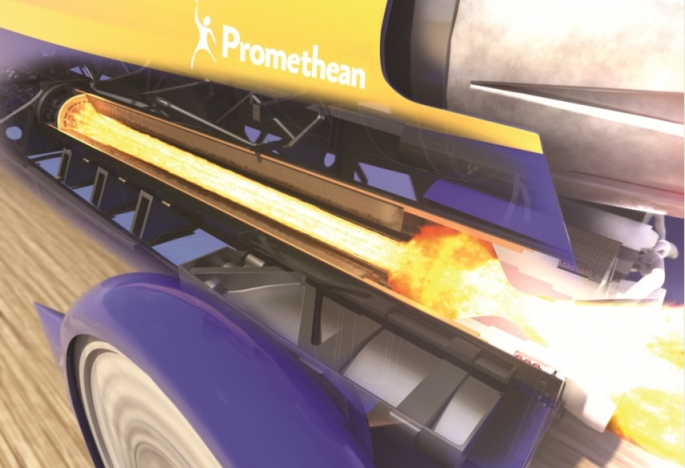
There are four main elements to BLOODHOUND’s propulsion package: the combustion chamber (containing the solid fuel), the liquid oxidiser, its pumping system, and the associated control kit.
The rocket itself consists of a solid fuel made from synthetic rubber similar to that used in aircraft tyres (HTPB, or Hydroxyl-Terminated Polybutadiene,) with metal powders and burning rate modifiers added to the mix. This is contained within a composite case slung beneath BLOODHOUND’S other powerplant – a state of the art EJ200 jet engine, as used in a Eurofighter Typhoon.
The liquid oxidiser is concentrated hydrogen peroxide known as High Test Peroxide. In lower strength concentrations it is commonly used to bleach paper and in hair dyes.
During a record-run, 963 kg of liquid HTP has to be delivered into the rocket in under 20 seconds. This presents a significant technical challenge.
BLOODHOUND’s solution takes the form of a Cosworth CA2010 Formula 1 engine mounted to a pump from a 1960s’ Blue Steel cruise missile. Upgraded by the original designer, the pump is now 15% more efficient that its airborne predecessors and able to convert the 750 bhp produced by the V8 race engine into 1,100lb/in2 (76 Bar) of pressure and a flow rate of 105 lb/sec (47.6 kg/sec) – enough to fill a bath in three seconds.
The Cosworth engine is connected to the pump via a custom-designed gearbox, to accommodates the speed differential between the engine, which will rev to 18,000 rpm, and the HTP pump, which runs at 11,000. The unit uses an AP triple-plate racing clutch so, if necessary, the engine can be used simply to maintain pressure in BLOODHOUND’s hydraulics, without driving the HTP pump.
Unusually for a racing car, BLOODHOUND has its own on-board starter motor. The traditional Formula 1 pit lane method of sticking a starting lance into the back of the gearbox won’t work as BLOODHOUND’s Cosworth F1 engine will be buried deep within the car.
The oxidiser is pumped onto the silver plated catalyst and decomposes into steam, oxygen and heat. The steam is superheated to 600°C and ignites the solid fuel grain, aided by the oxygen, and the temperature quickly reaches 3,000°C in side the rocket chamber. The rapidly expanding gasses are then channeled out the nozzle, generating thrust.
Prior to commencing a high speed run the Cosworth CA2010 F1 engine (also known as the Auxiliary Power Unit or APU) will be started and left idling at between 3000 and 4500 rpm. The oxidiser tank of HTP will be pressurized to 24 psi using inert nitrogen gas.
With the car accelerating under the power of the EJ200 jet engine alone, driver Andy Green will engage the APU with the pump via an AP Racing clutch and specially designed gearbox.
20 seconds into the run, with the speed approaching 230 mph, he will initiate Stage One of the firing sequence, priming the rocket by filling the HTP lines and pump with oxidiser and injecting a small quantity of HTP into the rocket. This will react with a silver catalyst pack mounted at front of the combustion chamber to create superheated steam and oxygen. As the solid rubber fuel begins to char in the 600°C temperature, heat haze and black smoke will issue from the rocket nozzle. As primary low-level combustion starts, this will turn into a powerful flame. The rocket is now primed, ready to deliver full power at Andy’s command.
At around 350 mph, 25 seconds into the run, the driver will depress the right-hand trigger on his steering wheel, summoning the full force of the Cosworth engine and starting Stage two of the sequence. As the maximum flow rate of HTP reaches the catalyst vast quantities of oxygen will be released, supporting the combustion of the fuel grain and generating 27,000 lbs (122 kN) of thrust, a 3000°C temperature at the nozzle and a 25-foot (7.6 m) long plume of flame studded with incandescent shock diamonds.
After 20 seconds of acceleration at up to 2.5G, BLOODHOUND SSC will have reached its maximum design speed of 1050 mph and will pass through the measured mile in 3.6 seconds. Just 120 seconds after setting off, the car will be stationary once more, 12 miles from its start point.
Even allowing for his many years experience flying fast jets, having to prime and fire the rocket, control the EJ200 and ensure that BLOODHOUND SSC is both on course and stable will tax Andy Green’s powers of concentration to the limit. If he fires too early the rocket could burn out before he reaches the end of the ‘flying mile’, if he fires too late he could be travelling too fast to stop safely at the other end.
- Ends -
For further information, please contact Jules Tipler jules.tipler@mettlepr.com / +44 (0) 7811 166 796
Animations can be viewed online at: www.youtube.com/1050mph also available in broadcast quality.
The rocket test will be streamed live to the internet via Ustream (www.BLOODHOUNDSSC.com/rocket) thanks to the Project’s Video and Communications Partner, Cisco.
Download a PDF version of this press release


